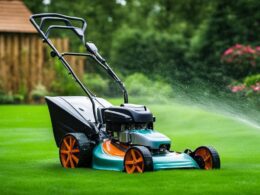Dealing with dead algae in your pool can be a frustrating experience. Not only does it detract from the beauty of your swimming pool, but it can also pose health risks. However, with the right cleanup tips and solutions, you can restore a safe and enjoyable swimming environment.
When tackling dead algae in your pool, it’s important to act quickly and effectively. One of the key steps in the cleanup process is using a multiport valve to divert the water and facilitate easy vacuuming. This ensures thorough removal of the algae, promoting crystal clear water.
While vacuuming, it’s advisable to refill the pool simultaneously. This allows for better circulation and filtration, buying more time to remove the algae completely. Once the algae is cleared, the pool should be refilled, and the filtration system should be reactivated.
Regular testing and maintenance of water chemistry are crucial to prevent future algae growth. By keeping a close eye on chlorine and pH levels, you can ensure that your pool remains clean and algae-free.
Tips for Removing Dead Algae from Your Pool
To effectively remove dead algae from your pool, you can follow these simple steps:
- Start by using a pool net to remove any large algae clumps floating on the surface of the water. This will help prevent them from sinking to the bottom.
- Next, grab a pool brush and scrub the walls and floor of the pool. Pay extra attention to areas where algae tend to accumulate, such as corners and stairs.
- After brushing, it’s time to bring out the pool vacuum. Use a pool vacuum with a fine mesh bag to ensure thorough removal of dead algae from the pool floor. Move the vacuum slowly and methodically to cover every inch of the floor.
- Once you’ve vacuumed the pool, it’s important to clean the pool filter. A dirty filter can hinder the filtration process and allow algae to thrive. Follow the manufacturer’s instructions to properly clean the filter.
- After cleaning the filter, make sure to run the pool pump and filtration system for at least 24 to 48 hours. This will help circulate and filter the water, removing any remaining debris or algae particles.
- Lastly, don’t forget to regularly test your pool water. Use a water testing kit to check the chlorine and pH levels. Adjust them as needed to maintain a healthy pool environment and prevent future algae growth.
By following these steps and incorporating regular pool maintenance into your routine, you can keep your pool clean and free from dead algae.
Pro Tip:
If you have a large pool or find it challenging to keep up with pool maintenance, consider investing in automated pool cleaning systems. These devices can help simplify the process of removing dead algae and keeping your pool sparkling clean.
Will Adding Baking Soda to My Pool Help with Dead Algae Cleanup?
Adding baking soda to your pool can help with dead algae cleanup by increasing the alkalinity of the water, making it inhospitable for algae growth. However, to ensure effectiveness, it is important to follow the recommended waiting time after adding baking soda before testing the water and making any further adjustments.
Understanding and Preventing Pool Algae
Pool algae can be caused by various factors, including low chlorine levels, poor water chemistry, and inadequate filtration. To effectively combat pool algae, it’s important to understand the different types that can occur, such as green algae, yellow algae (also known as mustard algae), black algae, and even pink algae.
Among these, green algae is the most common and relatively easier to eliminate. It typically appears as a greenish film on pool surfaces. However, yellow and black algae pose greater challenges, as they are more resistant and can form stubborn patches in hard-to-reach areas of the pool.
While pink algae isn’t a true algae but a type of bacteria, it can still thrive in pools. It usually manifests as pink slime or spots on pool surfaces. Understanding the causes and identifying the types of pool algae can help you develop an effective strategy to treat and prevent its growth.
To prevent pool algae, it’s crucial to maintain proper water chemistry by regularly testing and adjusting chlorine and pH levels. Additionally, keeping the pool filter system clean and running it regularly will help remove any potential algae spores. Furthermore, it’s advisable to wash off swimwear or toys that have been used in natural bodies of water before introducing them to the pool, as they may potentially introduce algae or bacteria.









